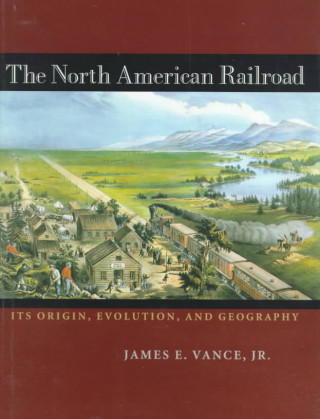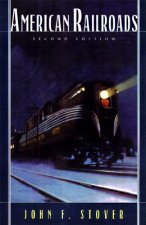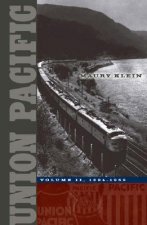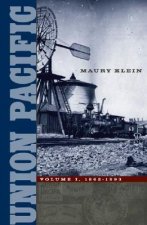
Kód: 04708509
North American Railroad
Autor James E. Vance
This work offers an account of where and why rail lines were built in various regions and at different times across the North American continent. It tells why the United States and Canada developed distinctive forms of rail techno ... celý popis
- Jazyk:
 Angličtina
Angličtina - Vazba: Pevná
- Počet stran: 384
Nakladatelství: Johns Hopkins University Press, 1995
- Více informací o knize

992 Kč
Dostupnost:
50 % šance Máme informaci, že by titul mohl být dostupný. Na základě vaší objednávky se ho pokusíme do 6 týdnů zajistit.
Máme informaci, že by titul mohl být dostupný. Na základě vaší objednávky se ho pokusíme do 6 týdnů zajistit.Prohledáme celý svět
Mohlo by se vám také líbit
-

Rolls-Royce From the Inside
606 Kč -

Canal du Midi
507 Kč -

Literature of China in the Twentieth Century
1257 Kč -

Law & it's Fulfillment
728 Kč -

Naturally Human, Supernaturally God
795 Kč -

Kristeva in Focus
1117 Kč -

Nights
553 Kč
Darujte tuto knihu ještě dnes
- Objednejte knihu a zvolte Zaslat jako dárek.
- Obratem obdržíte darovací poukaz na knihu, který můžete ihned předat obdarovanému.
- Knihu zašleme na adresu obdarovaného, o nic se nestaráte.
Informovat o naskladnění knihy
Zadejte do formuláře e-mailovou adresu a jakmile knihu naskladníme, zašleme vám o tom zprávu. Pohlídáme vše za vás.
Více informací o knize North American Railroad
Nákupem získáte 99 bodů
 Anotace knihy
Anotace knihy
This work offers an account of where and why rail lines were built in various regions and at different times across the North American continent. It tells why the United States and Canada developed distinctive forms of rail technology surprisingly different from those of Britain, where railroading originated, and explains how these developments convey with particular clarity the continent's unique historical geography. The author takes issue with the commonly held belief that a single rail technology spread from Britain to the rest of the world. Instead, he argues, two distinct traditions of railroad building and utilization developed simultaneously - beginning in Britain around 1825 and in the United States around 1830. One defining difference, Vance explains, was that the construction of rail lines in North America was contingent on a potential market rather than an existing one. But an even greater factor was geography. Because of the great length of lines and the considerable physical barriers to rail development, North American rail companies developed powerful locomotives instead of building the costly engineering works customary in England. Few American lines had extensive tunnels or bridges because the railroads followed the terrain as closely as possible. The North American system, Vance concludes, was a mirror image of the British model of weak engines and superb infrastructure. Vance also explores the railroad's singular role in defining North American space, as lines crossed so varied and undeveloped a landscape. By 1917 the North American railnet had transformed the continent and become the most comprehensive in the world - with a quarter of the world's trackage built in the United States alone, and a third in the US and Canada combined.
 Parametry knihy
Parametry knihy
Zařazení knihy Knihy v angličtině Economics, finance, business & management Industry & industrial studies Transport industries
992 Kč
- Plný název: North American Railroad
- Podnázev: Its Origin, Evolution and Geography
- Autor: James E. Vance
- Jazyk:
 Angličtina
Angličtina - Vazba: Pevná
- Počet stran: 384
- EAN: 9780801845734
- ID: 04708509
- Nakladatelství: Johns Hopkins University Press
- Hmotnost: 1250 g
- Rozměry: 210 × 279 × 33 mm
- Datum vydání: 02. October 1995
Oblíbené z jiného soudku
-

Wreck of the Penn Central
1161 Kč -

American Railroads
918 Kč -

Box
464 Kč -

Lost Tramways of Wales: South Wales and Valleys
250 Kč -

Air Babylon
356 Kč -

English for Cabin Crew
1456 Kč -

First Tycoon
523 Kč -

Airport Operations, Third Edition
1638 Kč -

Union Pacific
728 Kč -

Corn Belt Route
1351 Kč -

Erie Lackawanna
884 Kč -

Classic Jaguar XK
750 Kč -

Cruising Attitude
361 Kč -

Helvetica and the New York City Subway System
1153 Kč -

Rover 800 Series
750 Kč -

Titanic Captain
540 Kč -

Aerotropolis
523 Kč -

Low Cost Carrier Worldwide
1828 Kč -

Lowe's Transport Manager's and Operator's Handbook 2021
1769 Kč -

Airport Design and Operation
7378 Kč -

Traffic Engineering Handbook 7e
4266 Kč -

Autocars Et Autobus Berliet
1748 Kč -

Deep Sea and Foreign Going
416 Kč -

Airworthiness
3552 Kč -

English for Cabin Crew: Audio CD
1009 Kč -

Branch Lines Around Portmadoc, 1923-46
738 Kč -

Aircraft Safety
1063 Kč -

Lighthouses
211 Kč -

Mapping the Airways
536 Kč -

Project Apollo: The Moon Landings, 1968 - 1972
593 Kč -

Towards Sustainable Aviation
1299 Kč -

Crash Detectives
356 Kč -

London by Design
631 Kč -

Transport Operator Licensing
1514 Kč -

Trains, Buses, People
1297 Kč -

Intercity Bus Lines Of The Southwest
521 Kč -

Rise and Fall of Harland and Wolff
507 Kč -

Union Pacific
730 Kč -

Fighting Traffic
1021 Kč -

British Aircraft Manufacturers Since 1909
614 Kč -

Safety is No Accident: From 'V' Bombers to Concorde
677 Kč -

Building Agreement
302 Kč -

Human Factors in Multi-Crew Flight Operations
2341 Kč -

Practical Aviation Security
3232 Kč -

Straight and Level
1612 Kč -

Sustainable Aviation Futures
5140 Kč -

Blue Funnel Line
595 Kč -

Dictionary of Aviation
778 Kč -

Buying the Big Jets
2108 Kč
Osobní odběr Praha, Brno a 12903 dalších
Copyright ©2008-24 nejlevnejsi-knihy.cz Všechna práva vyhrazenaSoukromíCookies


 Vrácení do měsíce
Vrácení do měsíce 571 999 099 (8-15.30h)
571 999 099 (8-15.30h)